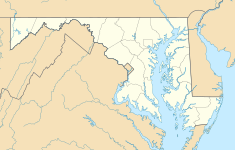Patapsco Hotel
| Patapcso Hotel | |
|---|---|
| Nearest city | Ellicott City, Maryland |
| Area | Ellicott City, Maryland |
| Built | Early 1900s, rebuilt 1927–1930 |
| Architectural style(s) | Stone |
The Patapsco Hotel is historic granite building located in Ellicott City, Maryland, on the western bank of the Patapsco River.
The current Patapsco Hotel is built with materials from an older granite construction hotel on the same site and is known as the Thomas' Patapsco Hotel, Wilson Patapsco Hotel, Stewart's Hotel, and McGowan's Hotel.
The original Thomas' Hotel was four stories tall made of local quarried granite stone block. The rear wall of the first floor is imbedded into a solid granite hillside. It served as a stagecoach stop along the National Pike road. The hotel was later called Stewart's Hotel featuring a bar and bowling alley. In 1806, Chief Little Turtle of the Miami people, Chief of the Rusheville people, Beaver Crow of the Delawares, Chiefs of the Shawanese, and the chief Raven of the Potowatomies visited George Ellicott staying at his home and the Hotel while returning from a visit to Washington, D.C.[1] The second floor balcony led to and served as an unloading terminal for the B&O Railroad at Ellicott's Mills.[2] Henry Clay once performed a speech from the balcony during a presidential campaign.[3][4] During the civil war, the hotel was considered a host of Southern Sedition. The Hotel operated as late as 1879.[5] For a period the hotel was used for an ice house for a period.[6] In 1920, the hotel owned by Hezekiah I Thomas was not in use with the windows broken and the county condemned the property. In 1926 a wall adjacent the railroad collapsed, causing street car service to be halted. Passenger cars had to halt as an inspector would check for enlargement of cracks before they could pass the building.[7] [8]
A new twelve-bay-wide, four-bay-deep three-story building was constructed on the same site with the same granite stones named the Patapsco Hotel. The original foundation was used, including some standing walls. The building was converted into an apartment house in the 1940s.[9] The building now houses shops on the bottom floor and apartments above.[10] The Property was later purchased by Samuel H. Caplan who operated several long standing businesses in Ellicott City.[11]
See also
References
- ^ Janet P. Kusterer, Victoria Goeller. Remembering Ellicott City: Stories from the Patapsco River Valley. p. 26.
- ^ "Passer Out at Ellicott's Mills--A Stroll Through the Village--The Streets--The Artistical Bridge--The Colassal Granite Cotton Factory--The Shovel and Spade Factory". The Baltimore Sun. 21 Feb 1855.
- ^ Janet P. Kusterer, Victoria Goeller. Remembering Ellicott City: Stories from the Patapsco River Valley. p. 1.
- ^ Maryland: A New Guide to the Old Line State By Earl Arnett, Robert J. Brugger, Edward C. Papenfuse. p. 420.
- ^ Celia M. Holland (1970). Ellicott City, Maryland, Mill Town, U.S.A.: A Historic Tour of Maryland's Unique 18th Century Mill Town, and a Partial Account of the Lives of Some of Its Outstanding Residents, Both Past and Present. Adams Press. p. 39.
- ^ Laura Rice. Maryland History in Prints 1743–1900. p. 92.
- ^ "Street Cars Cease Passing Old Ellicott City Hotel: Unsafe Condition Of Walls Of McGowan Structure Causes Precautions". The Baltimore Sun. 29 March 1926.
- ^ "Demolition Of McGowan's Hotel, Long Famous, To Begin Tomorrow: Ellicott City Landmark, Gathering Place For Epicures, Sportsmen And Politicians In Antebellum Days, Adjudged Public Menace". The Baltimore Sun. 4 April 1926.
- ^ Maryland, a Guide to the Old Line State, By Best Books on, Federal Writers' Project. p. 329.
- ^ Janet Kusterer, Victoria Goeller. Ellicott City. p. 36.
- ^ "HO-70 Patapsco Hotel" (PDF). Retrieved 8 January 2015.

